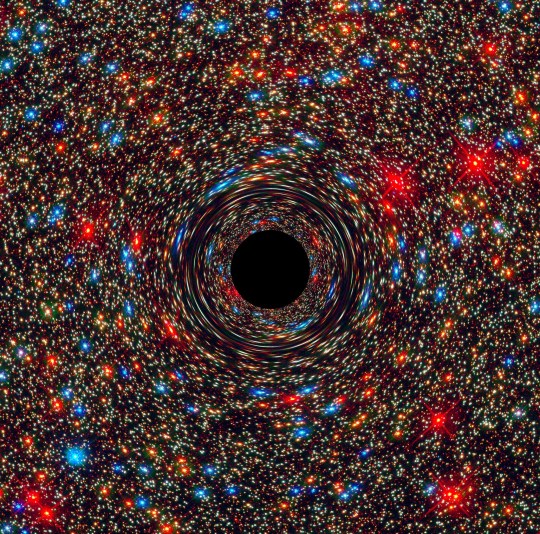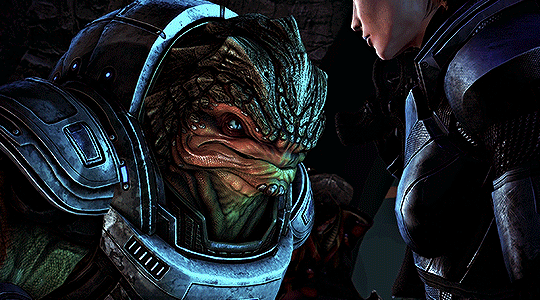Geek, fanfic writer, and autistic bi hot mess. Sometimes, I reblog. Other times, I express my thoughts.
Don't wanna be here? Send us removal request.
Video
youtube
Star Wars 5e | The Wound in the Force | Episode 21
0 notes
Text
May or may not have just spontaneously spent the last two or three hours or so typing out a chronological Star Wars watch order including listing every individual episode of each series because I'm a psychopath and a masochist
235 notes
·
View notes
Text
I feel like it's easy to rile up the Hellaverse (Hazbin Hotel and Helluva Boss) fandom. Just talk smack with even the mildest criticism and watch the fireworks.
#vivziepop#helluva boss#hazbin hotel#vivziepop critical#vivzie critical#vivziepop criticism#hellaverse
15 notes
·
View notes
Text
Seeing the Invisible Universe

This computer-simulated image shows a supermassive black hole at the core of a galaxy. The black region in the center represents the black hole’s event horizon, beyond which no light can escape the massive object’s gravitational grip. The black hole’s powerful gravity distorts space around it like a funhouse mirror. Light from background stars is stretched and smeared as it skims by the black hole. You might wonder — if this Tumblr post is about invisible things, what’s with all the pictures? Even though we can’t see these things with our eyes or even our telescopes, we can still learn about them by studying how they affect their surroundings. Then, we can use what we know to make visualizations that represent our understanding.
When you think of the invisible, you might first picture something fantastical like a magic Ring or Wonder Woman’s airplane, but invisible things surround us every day. Read on to learn about seven of our favorite invisible things in the universe!
1. Black Holes

This animation illustrates what happens when an unlucky star strays too close to a monster black hole. Gravitational forces create intense tides that break the star apart into a stream of gas. The trailing part of the stream escapes the system, while the leading part swings back around, surrounding the black hole with a disk of debris. A powerful jet can also form. This cataclysmic phenomenon is called a tidal disruption event.
You know ‘em, and we love ‘em. Black holes are balls of matter packed so tight that their gravity allows nothing — not even light — to escape. Most black holes form when heavy stars collapse under their own weight, crushing their mass to a theoretical singular point of infinite density.
Although they don’t reflect or emit light, we know black holes exist because they influence the environment around them — like tugging on star orbits. Black holes distort space-time, warping the path light travels through, so scientists can also identify black holes by noticing tiny changes in star brightness or position.
2. Dark Matter

A simulation of dark matter forming large-scale structure due to gravity.
What do you call something that doesn’t interact with light, has a gravitational pull, and outnumbers all the visible stuff in the universe by five times? Scientists went with “dark matter,” and they think it's the backbone of our universe’s large-scale structure. We don’t know what dark matter is — we just know it's nothing we already understand.
We know about dark matter because of its gravitational effects on galaxies and galaxy clusters — observations of how they move tell us there must be something there that we can’t see. Like black holes, we can also see light bend as dark matter’s mass warps space-time.
3. Dark Energy

Animation showing a graph of the universe’s expansion over time. While cosmic expansion slowed following the end of inflation, it began picking up the pace around 5 billion years ago. Scientists still aren’t sure why.
No one knows what dark energy is either — just that it’s pushing our universe to expand faster and faster. Some potential theories include an ever-present energy, a defect in the universe’s fabric, or a flaw in our understanding of gravity.
Scientists previously thought that all the universe’s mass would gravitationally attract, slowing its expansion over time. But when they noticed distant galaxies moving away from us faster than expected, researchers knew something was beating gravity on cosmic scales. After further investigation, scientists found traces of dark energy’s influence everywhere — from large-scale structure to the background radiation that permeates the universe.
4. Gravitational Waves

Two black holes orbit each other and generate space-time ripples called gravitational waves in this animation.
Like the ripples in a pond, the most extreme events in the universe — such as black hole mergers — send waves through the fabric of space-time. All moving masses can create gravitational waves, but they are usually so small and weak that we can only detect those caused by massive collisions. Even then they only cause infinitesimal changes in space-time by the time they reach us. Scientists use lasers, like the ground-based LIGO (Laser Interferometer Gravitational-Wave Observatory) to detect this precise change. They also watch pulsar timing, like cosmic clocks, to catch tiny timing differences caused by gravitational waves.
This animation shows gamma rays (magenta), the most energetic form of light, and elusive particles called neutrinos (gray) formed in the jet of an active galaxy far, far away. The emission traveled for about 4 billion years before reaching Earth. On Sept. 22, 2017, the IceCube Neutrino Observatory at the South Pole detected the arrival of a single high-energy neutrino. NASA’s Fermi Gamma-ray Space Telescope showed that the source was a black-hole-powered galaxy named TXS 0506+056, which at the time of the detection was producing the strongest gamma-ray activity Fermi had seen from it in a decade of observations.
5. Neutrinos

This animation shows gamma rays (magenta), the most energetic form of light, and elusive particles called neutrinos (gray) formed in the jet of an active galaxy far, far away. The emission traveled for about 4 billion years before reaching Earth. On Sept. 22, 2017, the IceCube Neutrino Observatory at the South Pole detected the arrival of a single high-energy neutrino. NASA’s Fermi Gamma-ray Space Telescope showed that the source was a black-hole-powered galaxy named TXS 0506+056, which at the time of the detection was producing the strongest gamma-ray activity Fermi had seen from it in a decade of observations.
Because only gravity and the weak force affect neutrinos, they don’t easily interact with other matter — hundreds of trillions of these tiny, uncharged particles pass through you every second! Neutrinos come from unstable atom decay all around us, from nuclear reactions in the Sun to exploding stars, black holes, and even bananas.
Scientists theoretically predicted neutrinos, but we know they actually exist because, like black holes, they sometimes influence their surroundings. The National Science Foundation’s IceCube Neutrino Observatory detects when neutrinos interact with other subatomic particles in ice via the weak force.
6. Cosmic Rays

This animation illustrates cosmic ray particles striking Earth's atmosphere and creating showers of particles.
Every day, trillions of cosmic rays pelt Earth’s atmosphere, careening in at nearly light-speed — mostly from outside our solar system. Magnetic fields knock these tiny charged particles around space until we can hardly tell where they came from, but we think high energy events like supernovae can accelerate them. Earth’s atmosphere and magnetic field protect us from cosmic rays, meaning few actually make it to the ground.
Though we don’t see the cosmic rays that make it to the ground, they tamper with equipment, showing up as radiation or as “bright” dots that come and go between pictures on some digital cameras. Cosmic rays can harm astronauts in space, so there are plenty of precautions to protect and monitor them.
7. (Most) Electromagnetic Radiation

The electromagnetic spectrum is the name we use when we talk about different types of light as a group. The parts of the electromagnetic spectrum, arranged from highest to lowest energy are: gamma rays, X-rays, ultraviolet light, visible light, infrared light, microwaves, and radio waves. All the parts of the electromagnetic spectrum are the same thing — radiation. Radiation is made up of a stream of photons — particles without mass that move in a wave pattern all at the same speed, the speed of light. Each photon contains a certain amount of energy.
The light that we see is a small slice of the electromagnetic spectrum, which spans many wavelengths. We frequently use different wavelengths of light — from radios to airport security scanners and telescopes.
Visible light makes it possible for many of us to perceive the universe every day, but this range of light is just 0.0035 percent of the entire spectrum. With this in mind, it seems that we live in a universe that’s more invisible than not! NASA missions like NASA's Fermi, James Webb, and Nancy Grace Roman space telescopes will continue to uncloak the cosmos and answer some of science’s most mysterious questions.
Make sure to follow us on Tumblr for your regular dose of space!
4K notes
·
View notes
Note
I think I realize why hazbin hotel and hellvua boss is so heavily criticized. In my opinion we’ve all grew out of that edgy, immature, raunchy humor and consumed better and far more in depth entertainment no matter what genre in any form be it anime or cartoons or indie or mainstream.
Agreed. We just realized we could do better while Vivziepop stayed in that stage.
21 notes
·
View notes
Video
youtube
Star Wars 5e | The Wound in the Force | Episode 20
0 notes
Video
youtube
Star Wars 5e | The Wound in the Force | Episode 19
0 notes
Text

Well, uh Sai is an alleged racist... Didn't see that coming. This person is a Viv stan, SU stan/fanartist, and often a Lily Orchard critic, which is ironic.
Please take this with a grain of salt.
If this is real, fuck you Sai. Just... fuck you.
85 notes
·
View notes
Text

Artemis Astronauts Have Drills, Too!
Chances are, if you have ever spent time in a school or office building, you have experienced a fire drill. Well, astronauts practice emergency drills, too!

Since we began sending astronauts to space, we have used systems and drills to practice moving people safely away from the launch pad in the unlikely event of an emergency during the countdown to launch.

Early Mercury and Gemini programs in the 1960s used a launch escape system in the form of a solid rocket motor that could pull the astronauts to safety in the event of an emergency. However, this system only accounted for the astronauts, and not other personnel at the launch pad. NASA’s emergency systems have since improved substantially to include everyone.
youtube
Artemis II will be NASA’s first mission with crew aboard the SLS (Space Launch System) rocket and Orion spacecraft. Artemis II will fly around the Moon and come back to Earth. Beginning with the Artemis II mission, we will use a track cable to connect the mobile launcher — the ground structure that supports the rocket before and during launch — to the perimeter of the launch pad. Picture a gondola ski lift beginning at the top of the rocket and ending all the way down to the ground. In case of an emergency, astronauts and support crews move from the capsule into the crew access arm, climb into one of four baskets waiting for them, and ride down to the ground.

There, members of the Pad Rescue team are ready to scoop the astronauts up and whisk them to safety. Think of the Pad Rescue team as spaceflight knights in shining armor. Except instead of saving crew from a fire breathing dragon, they are whisking the astronauts away from a fully loaded skyscraper-sized rocket that’s getting ready to lift off.

The Artemis II mission will also introduce several new ground systems for the first time – including the new and improved braking system similar to what roller coasters use! Though no NASA mission to date has needed to use its ground-based emergency system during launch countdown, those safety measures are still in place and maintained as a top priority.
So the next time you practice a fire drill at school or at work, remember that these emergency procedures are important for everyone to stay safe — even astronauts.
Make sure to follow us on Tumblr for your regular dose of space!
2K notes
·
View notes
Video
youtube
Play and Talk | Season 2 | Episode 1
0 notes
Video
youtube
Indiana Jones and the Great Circle | Part 1 | The beginning of the punchening of Nazis
0 notes
Video
youtube
Star Wars 5e | The Wound in the Force | Episode 18
0 notes
Text
For anyone living in the US, call your Senators and Representatives because Senators Cantwell and Grassley (yes, you read that right) have introduced a bill that will rein in Trump's tariff powers.
Here's the contact page.
It's somewhat unfortunate that it took Switch 2 to remind gamers that yes, politics does, in fact, affect you whether you like it or not.
#nintendo#donald trump#nintendo switch 2#prices#tariffs#switch 2 prices#economy#politics#yep#it sucks#congress#call on congress#speak out#this is real
86 notes
·
View notes
Text







Mass Effect 3: Legendary Edition dev. BioWare
215 notes
·
View notes
Photo






Fantasy Is A Metaphor For The Human Condition, a comic about magic, and art, and speculative fiction, and being sick, and how they all intersect. Originally laid out/pencilled November-December 2017, when I was in a very difficult place emotionally as I was relearning how to draw post-brain injury.
See more of my Brain Injury Comix at this link & in Dirty Diamonds #9: Being
153K notes
·
View notes
Text
5 Unpredictable Things Swift Has Studied (and 1 It’s Still Looking For)
Our Neil Gehrels Swift Observatory — Swift for short — is celebrating its 20th anniversary! The satellite studies cosmic objects and events using visible, ultraviolet, X-ray, and gamma-ray light. Swift plays a key role in our efforts to observe our ever-changing universe. Here are a few cosmic surprises Swift has caught over the years — plus one scientists hope to see.

#BOAT
Swift was designed to detect and study gamma-ray bursts, the most powerful explosions in the universe. These bursts occur all over the sky without warning, with about one a day detected on average. They also usually last less than a minute – sometimes less than a few seconds – so you need a telescope like Swift that can quickly spot and precisely locate these new events.
In the fall of 2022, for example, Swift helped study a gamma-ray burst nicknamed the BOAT, or brightest of all time. The image above depicts X-rays Swift detected for 12 days after the initial flash. Dust in our galaxy scattered the X-ray light back to us, creating an extraordinary set of expanding rings.

Star meets black hole
Tidal disruptions happen when an unlucky star strays too close to a black hole. Gravitational forces break the star apart into a stream of gas, as seen above. Some of the gas escapes, but some swings back around the black hole and creates a disk of debris that orbits around it.
These events are rare. They only occur once every 10,000 to 100,000 years in a galaxy the size of our Milky Way. Astronomers can’t predict when or where they’ll pop up, but Swift’s quick reflexes have helped it observe several tidal disruption events in other galaxies over its 20-year career.

Active galaxies
Usually, we think of galaxies – and most other things in the universe – as changing so slowly that we can’t see the changes. But about 10% of the universe’s galaxies are active, which means their black hole-powered centers are very bright and have a lot going on. They can produce high-speed particle jets or flares of light. Sometimes scientists can catch and watch these real-time changes.
For example, for several years starting in 2018, Swift and other telescopes observed changes in a galaxy’s X-ray and ultraviolet light that led them to think the galaxy’s magnetic field had flipped 180 degrees.

Magnetic star remnants
Magnetars are a type of neutron star, a very dense leftover of a massive star that exploded in a supernova. Magnetars have the strongest magnetic fields we know of — up to 10 trillion times more intense than a refrigerator magnet and a thousand times stronger than a typical neutron star’s.
Occasionally, magnetars experience outbursts related to sudden changes in their magnetic fields that can last for months or even years. Swift detected such an outburst from a magnetar in 2020. The satellite’s X-ray observations helped scientists determine that the city-sized object was rotating once every 10.4 seconds.

Comets
Swift has also studied comets in our own solar system. Comets are town-sized snowballs of frozen gases, rock, and dust. When one gets close to our Sun, it heats up and spews dust and gases into a giant glowing halo.
In 2019, Swift watched a comet called 2I/Borisov. Using ultraviolet light, scientists calculated that Borisov lost enough water to fill 92 Olympic-size swimming pools! (Another interesting fact about Borisov: Astronomers think it came from outside our solar system.)

What's next for Swift?
Swift has studied a lot of cool events and objects over its two decades, but there are still a few events scientists are hoping it’ll see.
Swift is an important part of a new era of astrophysics called multimessenger astronomy, which is where scientists use light, particles, and space-time ripples called gravitational waves to study different aspects of cosmic events.

In 2017, Swift and other observatories detected light and gravitational waves from the same event, a gamma-ray burst, for the first time. But what astronomers really want is to detect all three messengers from the same event.
As Swift enters its 20th year, it’ll keep watching the ever-changing sky.
Keep up with Swift through NASA Universe on X, Facebook, and Instagram. And make sure to follow us on Tumblr for your regular dose of space!
2K notes
·
View notes

